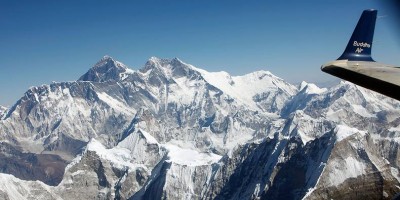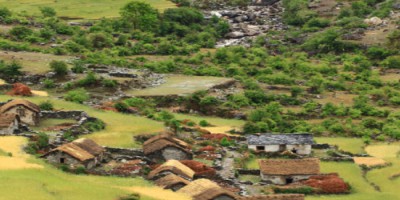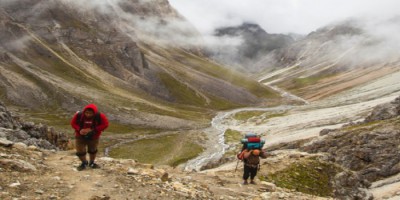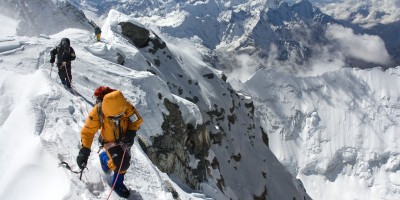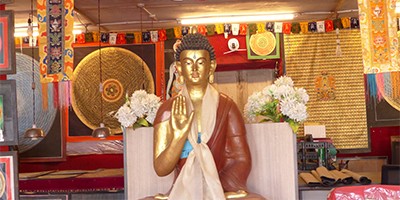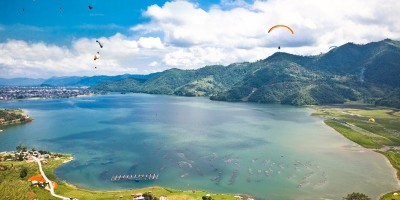About Nepal Climate & Culture etc....
Unknown facts about Nepal.......
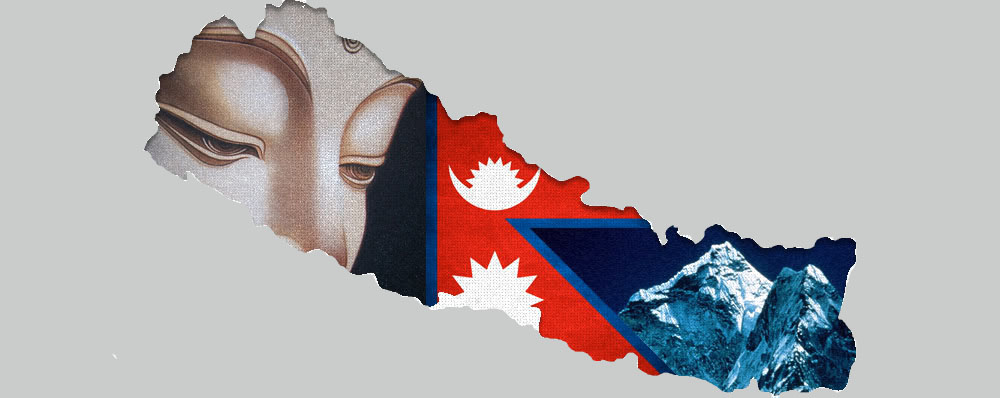
Welcomes you to Nepal…
A Heaven on Earth
Nepal is one of the richest countries in the world in terms of bio-diversity due to its unique geographical position and altitude variation. The elevation of the country ranges from 60 meters above sea level to the highest point on earth, Mt. Everest at 8,848 meters, all within a distance of 150 kilometers resulting in climatic conditions from sub-tropical to arctic. This wild variation fosters an incredible variety of ecosystems, the greatest mountain range on earth, thick tropical jungles teeming with a wealth of wildlife, thundering rivers, forested hills and frozen valleys
Within this spectacular geography is also one of the richest cultural landscapes anywhere. The country is a potpourri of ethnic groups and sub-groups who speak over 70 languages and dialects. Nepal offers an astonishing diversity of sightseeing attractions and adventure opportunities found nowhere else on earth. And you can join in the numerous annual festivals that are celebrated throughout the year in traditional style highlighting enduring customs and beliefs.
The most exhilarating titles with which Nepal has been admired and praised by various renowned travel writers in recognition of her cultural richness,
Living cultural Museum
Shangri-La
Roof of the World
Birth place of the Apostle of Peace
Country of Living Goddess
City of Golden Pagodas and Parasols
Himalayan Pilgrimage
Nature amphitheatre
Melting pot of Hinduism and Buddhism
A tiny Kingdom of 36 ethnic groups and 75 spoken languages
Birth place of Sita
Abode of Shiva
Land of Mysticism & Exoticism
Land of non-stop festivals
Nepal - occupying only 0.1% of the earth - is home to:
2% of all the flowering plants in the world
8% of the world's population of birds (more than 848 species)
4% of mammals on earth
11 of the world's 15 families of butterflies (more than 500 species)
600 indigenous plant families
319 species of exotic orchids
Nepal Fact-Sheet
Area: 147,181 sq. km
Geography: Situated between China in the north and India in the South
Location: Latitude: 26°12' to 30°27' North Longitude:80°4' to 88°12' East.
Capital: Kathmandu
Population: 23 million
People: More than 60 ethnic groups and 70 spoken languages
Language: Nepali
Climate: sub-tropical in low lands to arctics in higher altitudes
Currency: Nepalese Rupee
Political System: Multiparty democracy with constitutional monarchy.
National Bird: Impean Pheasant (Danfe).
National Flower: Rhododendron Arboreum (Lali Gurans).
Topography: From the worlds deepest gorge 'Kali-Gandaki' to highest point on earth 'The Everest'.
Vegetation: Nepal possesses some of the most outstanding bio-diversity in the world, ranging from sub-tropical Rain-forests to Alpine deserts.
Endangered Species:
Tiger, Rhino, Snow - leopard, Red panda, Brown bear, Assamese macaque, Gangetic dolphin, Wolf, Wild elephant , Giant horn-bill, Swamp deer, Wild yak, Tibetan antelope, Black buck, Four horned antelope, Musk deer, Pigmy hog, Haspid hare, Pangolin, Gharial, Indian bustard, Saras crane, Impean pheasant, Python.
Wildlife:
One horned rhino, Royal Bengal tiger, Snow-leopard, Clouded-leopard, Red panda, Blue-sheep, Long snouted fish eating Gharial, wild elephant , buffaloes, bisons, blue bull, brown bear, leopard, crocodiles and many varieties of cat, dog, deer and antelope families and 840 different species of wet-land, migratory and residential birds.
A Living Cultural Heritage:
Our heritage is alive and dynamic. Shamanism, Pan-animism & Witch-craft are still practiced in remote regions. Temples, shrines, monuments and monasteries are extremely active with devotees burning butter-lamps, singing hymns, chiming temple bells and playing drums.
Traveling by air
You can fly directly to Kathmandu from London, Paris, Frankfurt, Vienna, Amsterdam, Doha, Dubai, Dhaka, Karachi, Munich, Abu Dhabi, Bahrain, Paro, Lhasa, Singapore, Kuala Lumpur, Bangalore, New Delhi, Mumbai, Patna, Calcutta and Varanasi. Charter flights can also be arranged for large movements. All flights feature business class and amenities of international standards. Many a time, the Captain offers a guided sightseeing of the Himalaya for no extra charge!
Royal Nepal Airlines, Thai Airways, Qatar Airways, Indian Airlines, Pakistan International Airlines, Biman Bangladesh, Gulf Air, Indian Airlines, Air Sahara, Jet Airways, Austrian Air, Martinair, Air China, Druk Air fly to Nepal regularly.
Airfares fluctuate with the changes in exchange rates and are to be paid in foreign currency by foreign nationals. Only Nepalese and Indian nationals are permitted to pay in rupees for air passage between Nepal and India. Departure flight tickets should be reconfirmed three days in advance to avoid inconveniences by possible flight cancellation or changes in the flight schedule. Overweight luggage charges are levied in foreign exchange.
Customs: All baggage must be declared and cleared through the customs on arrival at the port of entry. Passengers arriving at Tribhuvan International Airport (TIA) without any dutiable goods can proceed through the Green Channel for quick clearance without a baggage check. If you are carrying dutiable articles, you have to pass through the Red Channel for detailed customs clearance.
Import: Apart from used personal belongings, visitors are allowed to bring to Nepal free of duty cigarette (200) or cigars (50), distilled liquor (one 1.15 liter bottle), and film (15 rolls). You can also bring in the following articles free of duty on condition that you take them out with you when you leave: binoculars, movie or video camera, still camera, laptop computer, and portable music system.
Export: It is illegal to export objects over 100 years old (sacred images, paintings, manuscripts) that are valued for culture and religious reasons. Visitors are advised not to purchase such items as they are Nepal's cultural heritage and belong here. The Department of Archaeology (tel: 4213701, 4213702) at Ramshah Path near Singha Durbar has to certify all metal statues, sacred paintings and similar objects before they are allowed to be sent or carried out of the country. Handicraft dealers and travel agents are able to assist you in this process. For more information on customs matters, contact the Chief Customs Administrator, TIA Customs Office; tel: 4470110, 4472266.
Airport Tax
DOMESTIC AIRPORT TAX: US$ 04.00 nett per pax
All visitors entering Nepal by land must use no other entry points other than:
Nepal-India border
Kakarbhitta
Birgunj
Belhiya, Bhairahawa
Nepalgunj
Dhangadi
Mahendra Nagar
Nepal-China border
Kodari
The overland tourists entering the Kingdom with their vehicles must possess an international carnet.
Climate
Nepal experiences 4 seasons spring (Mar - May), summer (Jun - Aug), autumn (Sep - Nov) and winter (Dec - Feb).
Temperature Chart
(in Celsius)
|
Months |
Kathmandu |
Pokhara |
Chitwan |
|||
|
|
Max |
min |
Max |
Min |
Max |
Min |
|
January |
19 |
2 |
20 |
8 |
24 |
7 |
|
February |
20 |
4 |
21 |
8 |
26 |
8 |
|
March |
25 |
8 |
27 |
11 |
33 |
12 |
|
April |
30 |
11 |
30 |
16 |
35 |
18 |
|
May |
30 |
16 |
30 |
19 |
35 |
20 |
|
June |
30 |
20 |
30 |
20 |
35 |
23 |
|
July |
20 |
21 |
30 |
21 |
33 |
24 |
|
August |
29 |
20 |
30 |
21 |
33 |
24 |
|
September |
27 |
19 |
29 |
20 |
32 |
22 |
|
October |
23 |
15 |
27 |
18 |
31 |
18 |
|
November |
23 |
4 |
23 |
11 |
29 |
12 |
|
December |
20 |
2 |
20 |
8 |
24 |
8 |
Rainfall Chart
(in mm.)
|
Months |
Kathmandu |
Pokhara |
Chitwan |
|
January |
25 |
15 |
10 |
|
February |
25 |
15 |
10 |
|
March |
75 |
30 |
10 |
|
April |
50 |
50 |
15 |
|
May |
100 |
300 |
200 |
|
June |
225 |
575 |
300 |
|
July |
375 |
800 |
500 |
|
August |
360 |
700 |
450 |
|
September |
175 |
575 |
400 |
|
October |
50 |
220 |
100 |
|
November |
10 |
20 |
5 |
|
December |
10 |
5 |
5 |
Entry Procedures & Visa Regulations
Gratis visa for all tourists who visit Nepal for 3 days or less.
Gratis visa for tourists of SAARC countries and People's Republic of China.
Visa Fee:
Single entry - US$ 30 for 60 days
Multiple entries - US$ 80 for 60 days.
1. The single entry tourist visa can be obtained from the entry points of Nepal or from the Royal Nepalese diplomatic missions abroad by paying US$ 30 or equivalent convertible foreign currency for 60 days.
2. Multiple entry facility can be obtained paying additional US$ 50 or equivalent convertible foreign currency. The facility will be valid for a visa year (Jan-Dec) of the visa period is valid.
3. The visitors who wish to stay for more than 60 days in Nepal can extend their tourist visa by paying the equivalent of US$ 30 in the Nepalese currency for 30 days from the Department of Immigration.
4. Business visa with multiple entry facility for the period of one year and five years can be obtained from the Department of Immigration on the recommendation of Ministry of Industry by paying the equivalent of US$ 100 and US$ 250 respectively in the Nepalese currency for the foreign investors.
Accommodation
Nepal has every category of accommodation facilities that range from the international standard star hotels to budget hotels and lodges. In order to have an assured quality service, it is advisable to use the facilities and services of government registered hotels, lodges, travel agencies, licensed tour guides only and engage an authorized trekking guide or porter only through a registered travel and trekking agency.
In the last few decades Kathmandu and Pokhara with the rest of Nepal has seen mushrooming of world class hotels. During spring and fall, the better hotels work at near full capacity and are booked well in advance. There are, however, plenty of less glamorous but decent hotels to suit everyone's fancies and finances. Most hotels offer choice of: bed and breakfast; bed, breakfast and one other meal; or room and full board. Rates listed however, are for room only, unless otherwise indicated. Besides officially recognized hotels, there are number of small lodge accommodations available between US $5 and $10 a night depending on facilities; toilets and showers are generally communal and heating is extra. These small hostelries are located in the old parts of Kathmandu and in the Thamel district.
Even in remote parts of Nepal, the coming of tourists over the years has led to the local population paying attention to tourist facilities, hence making accommodation and meals for tourists more easily available than before
Getting Around
Domestic air service
Royal Nepal Airlines (RA) has an extensive network of air services in the interior of Nepal. It has scheduled connection flights from Kathmandu to Taplejung, Bhadrapur, Rajbiraj, Bhojpur, Phaplu, Lukla, Lamidanda, Tunmlingtar, Rumjatar, Biratnagar Simara, Janakpur, Ramechhap, Bharatpur, Meghauli ,Pokhara, Jomsom, Manang, Baglung. Bhairahawa, Nepalgunj Chaurjhahari, Surkhet, Dang, Dolpa, Jumla, Bajura, Baitadi, Dipayal, Darchula, Mahendranagar, Dhangadi, Tikapur and Sanfebagar. Besides RA, other domestic airlines such as Buddha Air, Cosmic Air, Gorkha Airlines, Sita Air, Skyline Airlines and Yeti Airways provide regular and charter services to popular domestic destinations.
City buses
There are many buses, minibuses and microbuses available at Ratnapark (old Bus Park) which depart to different destinations in the valley. Safa tempo run by battery is available in Kathmandu for commuters.
Metered Taxi
Consult Kathmandu Valley map to find out the direction of your destination. Hail a taxi, which is easily recognizable by its taxi sign on top and black license plate. As a rough guide, a trip inside the city will cost anywhere between Rs. 20/- to 200/- (depending on the distance). No tip is expected. A metered taxi from the airport to downtown will cost about Rs. 200 to Rs. 400. Private taxis may charge slightly higher than the ordinary taxis. There is also an arrangement of Night Taxi service operated by the major hotels. The fare is slightly higher than the metered taxi. One can rent a private car through a travel agent or a car rental company.
Hired Mountain Bike / Ordinary Bicycle
Mountain bikes and ordinary bicycles are cheap and the best form of transportation for economy tourists. One can hire them at Thamel, Rani Pokhari and Jhochhen.
Long Distance Bus Service
Long distance day or night bus services are available from Kathmandu to all cities of Nepal. A new bus park has been constructed at Gongabu on the Ring Road near Balaju from where buses depart for the different destinations. Six seater Sumo Tata van, 12 seater van and air-conditioned mini bus also available for long distance travel
Foreign Currency and Credit Cards
Payment in hotels, travel agencies, and airlines are made in foreign exchange. Credit cards like American Express, Master and Visa are widely accepted at major hotels, shops, and restaurants. Remember to keep your Foreign Exchange Encashment Receipt while making foreign exchange payments or transferring foreign currency into Nepalese rupees. The receipts may be needed to change left-over Nepalese Rupees into hard currency before leaving the country. However, only 10 percent of the total amount may be converted by the bank. ATM is widely in use in Kathmandu. Major Banks, hotels, and the exchange counters at Tribhuvan Airport provide services for exchanging foreign currency.
Exchange rates are published in English dailies such as The Himalayan Times, The Rising Nepal, The Kathmandu Post and. Nepalese Rupees are found in denominations of 1000, 500, 100, 50, 20, 10, 5, 2 and 1. Coins are found in denominations of 10, 25 and 50 paisa. One rupee equals 100 paisa.
Time and Business Hours
Nepal is five hours 45 minutes ahead of GMT.
Business hours within the Valley: Government offices are open from 9 am to 5 p.m. from Monday through Friday in the Kathmandu Valley. Outside the Kathmandu Valley it opens on Sunday also. Banks are open from Sunday through Friday from 10 am to 3.30 pm. open until 12 pm only on Friday. Most Business offices are open from 10 am to 5 p.m. Sunday through Friday. Embassies and international organizations are open from 9 am to 5 pm Monday through Friday. Most shops open after 10 am and close at about 8 pm and are usually closed on Saturdays.
Business hours outside the Valley: Government offices outside Kathmandu valley open from 10 am to 5 p.m. from Sunday through Thursday. On Fridays they remain open until 3 pm. Banks are open from Sunday through Thursday from 10 am to 3 pm. On Fridays, banks remain open until 12 pm only. Business offices are open from 10 am to 5 pm Sunday through Friday. Embassies and international organizations are open from 9 am to 5 pm Monday through Friday. Most shops open after 10 am and close at about 8 pm and are usually closed on Saturdays.
Holidays: Nepal observes numerous holidays, at the least a couple in a month. So please check the holiday calendar. Government offices observe all the national holidays and banks observe most of them. Businesses observe major holidays only
Communication Facilities
Postal Services: The Central Post Office located near Dharahara Tower, is open from 9 a.m. to 5 p.m. Monday through Friday. The counters are open from 7 a.m. to 4 p.m. and provide stamps, postcards and aerograms. Post Restante is available Monday through Friday from 9 a.m. to 5 p.m. Express Mail Service (EMS) is available at GPO and at Thamel, Basantapur and airport postal counters.
Telephone Services: Telephone, fax, telex and telegraph services are available at the Nepal Telecommunications Corporation at Tripureshwar. Hotels and private communications centers provide long distance telephone.
Internet Services: Several Internet cafes and communication centers have opened up in the Valley and around the country in the past few years. Visitors only have to find a place they are most comfortable in to use the facilities to keep in touch with home. E-mail and Internet services are also offered by hotels.
Media: Nepali media has sped light years ahead in just a few years time and what used to be a controlled and tight knit community, is so no more. The government audio and television news networks are Radio Nepal and Nepal Television respectively. However, numerous FM radio stations and upcoming regional television stations are dominating the market. Major Nepali daily newspapers are Gorkhapatra and Kantipur, while the English dailies are The Rising Nepal, The Kathmandu Post and The Himalayan. A number of other newspapers and magazines are also available.
Electricity: Major towns have electricity and the voltage available is 220-volts and 50 cycles. Load shedding is sometimes experienced. However, most major hotels have installed their own generators
Health Guide
Insurance
A travel insurance policy that covers theft, loss and medical treatment is recommended. Make sure the insurance also covers the activities that you will be undertaking during your stay in Nepal such as trekking or river rafting.
Immunization
Nepal does not require any particular immunization for your visit. Vaccinations for Cholera, Meningitis, Tetanus & Diphtheria, Typhoid and Gamma Globulin should be considered for your trip. Please consult your physician and get a complete check -up before your departure.
Travel distance
|
Sectors |
Distance |
Approx. driving time |
|
Kathmandu/Dhulikhel |
30 kms |
45 min |
|
Kathmandu/Panauti |
30 kms |
1 hr |
|
Kathmandu/Nagarkot |
32 kms |
1 hr |
|
Kathmandu/Kakani |
29 kms |
1 hr |
|
Kathmandu/Trisuli |
69 kms |
3 hrs |
|
Kathmandu/Kodari |
114 kms |
4-5 hrs |
|
Kathmandu/Gorkha |
141 kms |
4-5 hrs |
|
Kathmandu/Bharatpur |
144 kms |
4-5 hrs |
|
Kathmandu/Pokhara |
205 kms |
6-7 hrs |
|
Kathmandu/Chitwan |
200 kms |
6-7 hrs |
|
Kathmandu/Birgunj |
270 kms |
7-8 hrs |
|
Kathmandu/Sunauli (Nepal/India border) |
286 kms |
8 hrs |
|
Kathmandu/Lumbini |
303 kms |
9-10 hrs |
|
Kathmandu/Tansen |
302 kms |
9-10 hrs |
|
Kathmandu/Bhairahawa |
282 kms |
10 hrs |
|
Kathmandu/Janakpur |
375 kms |
10-11 hrs |
|
Kathmandu/Nepalgunj |
531 kms |
12-13 hrs |
|
Kathmandu/Biratnagar |
541 kms |
12-13 hrs |
|
Kathmandu/Bhadrapur |
610 kms |
14-15 hrs |
|
Kathmandu/Bardia |
621 kms |
15-16 hrs |
IMPORTANT THINGS TO REMEMBER
a) The form of greeting in Nepal is "NAMASTE" and is performed by joining the palms together.
b) Before entering a Nepalese home, temple, and stupa remember to remove your shoes.
c) Never touch anything with your feet. This is considered an offence among Nepalese.
d) While traveling dress appropriately. Women should specially avoid dressing in skimpy outfits.
e) Seek permission first before entering a Hindu temple. Many Hindu temples do not allow westerners or non-Hindus to enter.
f) Leather articles are prohibited to be taken inside the temple precinct.
g) Walking around temples or stupas is traditionally done clockwise.
h) Take photographs only after receiving permission for the object or person being photographed.
i) Develop a genuine interest to meet and talk to Nepalese people and respect their local customs.
j) Please be sure that all your travel documents, including passports, visas and vouchers are in order and handy before leaving for the airport. Take particular care to keep your documents safe throughout your trip.
! Have a wonderful trip

